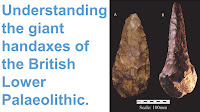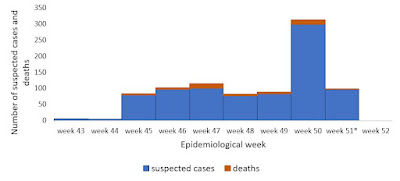A number of coastal archaeological sites across Southern Africa provide an excellent record of faunal and Hominin interactions during Pleistocene interglacial periods and the Holocene, but a much poorer record of the same during glacial periods, when sealevels were lower, with the effect that most coastal settlements during these intervals would be below modern sealevels. The Waterfall Bluff Rock Shelter in the Mpondoland region of Eastern Cape Province, appears to be an exception to this, with an archaeological record which begins during Marine Isotope Stage 3 (roughly 39 000 to 29 000 years ago) to the Early Holocene (about 8000 years ago), and includes the Last Glacial Maximum, and the glacial/interglacial transition at the end of the Pleistocene. This site has yielded the remains of Fish, Shelfish, and Marine Mammals, which demonstrate that the hunter-gatherer populations using the rock shelter were utilizing coastal resources even during the Last Glacial Maximum.
In a paper published in the South African Journal of Science on 4 December 2024, Sandee Oster and Jerome Reynard of the School of Geography, Archaeology and Environmental Studies at the University of the Witwatersrand, Hayley Cawthra of the African Centre for Coastal Palaeoscience at Nelson Mandela University, and the Minerals and Energy Unit at the South African Council for Geoscience, Irene Esteban, also of the African Centre for Coastal Palaeoscience at Nelson Mandela University, and of the Archaeological and Archaeometric Research Unit and Institute of Archaeology at the University of Barcelona, Justin Pargeter of the Department of Anthropology at New York University, and the Rock Art Research Institute at the University of the Witwatersrand, and Erich Fisher, again of the African Centre for Coastal Palaeoscience at Nelson Mandela University, and of the Evolutionary Studies Institute at the University of the Witwatersrand, the Interdisciplinary Center for Archaeology and the Evolution of Human Behavior at the University of Algarve, and the Institute of Human Origins at Arizona State University, present a preliminary analysis of the fauna at the Waterfall Bluff Rock Shelter, and discuss the implications of this for the local palaeoenvironmental and palaeoecological conditions, and how this would have affected the subsistence activities of hunter-gatherer populations in the area.
Eastern Mpondoland, defined as the area between the mouths of the Mthatha and Umtamvuna rivers, has a diverse landscape with a number of deeply incised plateaus, and areas of sourveld grassland, forest vegetation and bushveld, with patches of Southern Coastal Forest, Southern Mistbelt Forest and Scarp Forest. This area has a diverse fauna including woodland species such as bushbuck, Tragelaphus scriptus, Blue Duiker, Philantomba monticola, and Grey Rhebok, Pelea capreolus, grassland species such as Southern Reedbuck, Redunca arundinum, Oribi, Ourebia ourebi, and Bontebok, Damaliscus pygargus, as well as mixed environment species such as Eland, Tragelaphus oryx.
Waterfall Bluff Rock Shelter is located 24 m above sealevel, close to the Mlambomkulu River Waterfall. It has yielded an assemblage of lithic tools, predominantly made from hornfels (metamorphically altered sandstone), as well as Plant remains which have been used to demonstrate that all the vegatation types found in the area have been present since the End Pleistocene. More than 17 000 items have been recovered from the site to date, including tools, Plant, and Animal remains.
Two broad stratigraphic layers, termed Stratigraphic Aggregates, or 'StratAggs', have been determined from the rock shelter. These are somewhat homogenised internally, but apparently distinct from one-another. The oldest is the Light Brown Coarse Sands, which has been dated to between 37 600 and 12 500 years before the present. Overlying this is the Shell-Rich Clayey Sands, dated to between 11 000 and 10 500 years before the present, both of which can be sub-divided into a number of discrete sub-units, termed sub-Stratigraphic Aggregates, or 'SubAggs'.
The ages and locations of SubAggs at Waterfall Bluff. Oster et al. (2024).
The material used in Oster et al.'s study was excavated in 2016 under permit from the Eastern Cape Provincial Heritage Resources Authority, and with the support of King Zanozuko Tyelovuyo Sigcau, Nkosi Mthuthuzeli Mkwedini, and the Lambasi AmaMpondo community. Specimens were compared to reference material in the collection of the Ditsong National Museum. Where Bovid remains could not be identified they were split into four size classes, with (1) being the smallest, and including species such as Oribi, and (4) is the largest, including species such as Eland. Where the species could be determined, ungulates were categorised as grazers, browsers or mixed feeders.
The majority of the specimens came from the Early Holocene Shell-Rich Clayey Sands, with a smaller amount from the Late Pleistocene Light Brown Coarse Sands. The majority of the material was extremely fragmentary, typically less than 2 cm on the longest dimension. About 10% of the material showed signs of Human modification, such as cut or percussion marks, though only one of these modified bones could be assigned to species level, a charred astragalus with cut marks from the Early Holocene determined to come from a Blue Duiker.
The most common Animals in the sample were Bovids (the group that includes Antelopes), while the most easily identifiable remains were those of Rock Hyraxes, Procavia capensis. A single Seal-tooth was found in a Pleistocene layer dated to between 22 560 and 19 430 years before the present. This was determined to have come from a Leopard Seal, Hydrurga leptonyx, a species which today is found on Antarctic and sub-Antarctic islands, and the waters which surround these, although occasional visitors to South Africa are recorded. The presence of such a tooth in a Pleistocene layer at the Waterfall Bluff Rock Shelter could imply that during this period, when sea temperatures would have been about 3° lower that today, Leopard Seal colonies were found further north, on the South African coast, or simply that individuals occasionally visited the area, as they do today. Three Seal bone specimens were also found, a vertebra and two bone fragments, from both the Pleistocene and Holocene layers, although these could not be identified more precisely.

Leopard Seal tooth from Waterfall Bluff Rock Shelter (#CN47208, Lot 303). Oster et al. (2024).
Only two Bovid specimens could be identified from the Late Pleistocene deposits, a Common Duiker, which is an obligate woodland species, and an Eland, which is environmentally adaptable. No obligate grassland species could be identified, but with the very small sample size, it would be problematic to place much emphasis on this.
Both Fish and Seal remains were found in Late Pleistocene layers along with marine Shelfish and possible Barnacle fragments, suggesting that the area was within practical range of the coast even during periods of glaciation. This is not completely surprising as the coastal shelf is narrow on this part of the coast (i.e. at the edge of the continental shelf the seafloor is steep, so that the sealevel can drop a long way vertically without moving far horizontally), although even at this time it was probably about 8 km from the rock shelter.
In the Early Holocene, Bushbuck and Reedbuck were both common. Since these species favour riverine environments, suggesting that the Mlambomkulu River had continued to run at this time; this supports earlier findings of incisions on the (now submerged) continental shelf, which also support the presence of a river. Reedbuck also favour grassland environments, as do African Buffalo and Bontebok/Blesbok, which were also fairly common in the Holocene layers, suggesting a grassland environment was definitely present by this time. The presence of Blue Duiker and Vervet Monkeys, which are obligate woodland species, indicate that woodland was still present, hinting at an environment not much different from today.
See also...



































.jpg)
.jpg)













